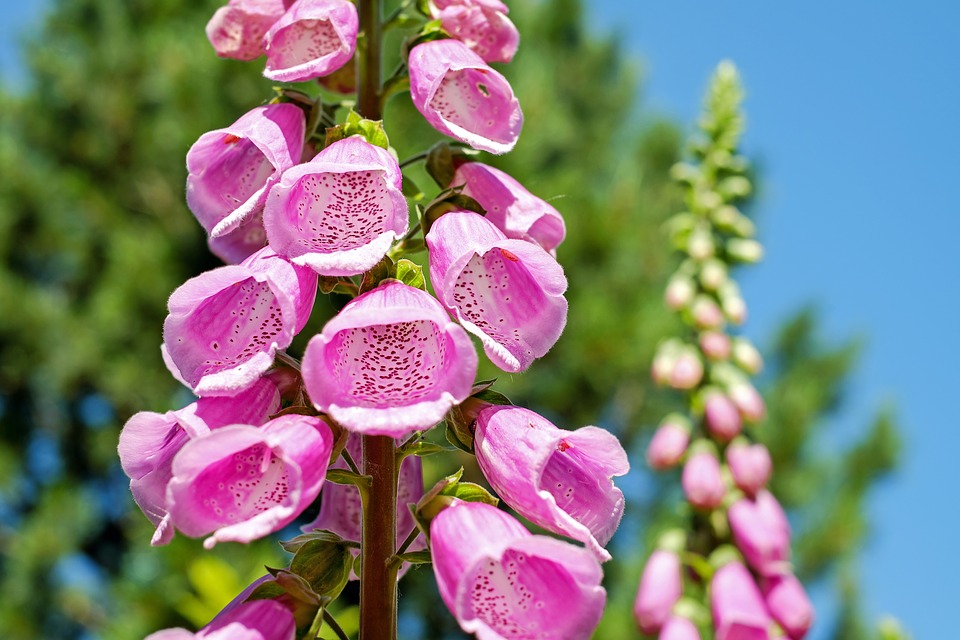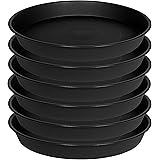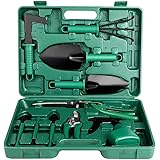Do foxgloves flower every year?
Foxgloves can flower yearly only with a perennial variety. Perennial foxgloves come back annually for three to five years. However, many types of foxgloves are biennial, especially those grown from seed. For biennial foxgloves, the foliage on the first year then bloom on the second year after planting, then die back.
Furthermore, foxgloves are self-seeding, which means you can enjoy a continuous bloom every year with the least effort. You will need to sow the seeds consecutively for two years to avoid flower gaps for this to happen.
Therefore, your choice of the variety of foxgloves will determine how frequently they flower.
But, not so fast! Like most plants, you will need to have prior information on the growing needs, toxicity, and even flowering schedule. So, here we go; read on.
Growing Foxgloves
Beautifully colored, bell-shaped foxglove blossoms look good anywhere you decide to plant them; ground or containers. Even better, they are easy to grow for both experts and amateur gardeners.
Moreover, you can use foxgloves in different settings like container displays, mixed perennial borders, and even conventional bedding out. Generally, you will want foxgloves in your garden to add color, drama, and vertical interest.
Usually, foxgloves thrive in conditions of partial or deep shade. However, varieties from the Mediterranean require a sunny position to do well.
Aside from lighter soils, foxgloves can also do well in a mixture of clay soil and organic matter like compost.
As mentioned, foxgloves come in different varieties that thrive in different flowering schedules and even colors. For instance;
- Digitalis ferruginea: Biennial or short-term perennial growth with yellowy-rusty-brown flowers.
- Digitalis Grandiflora: Perennial growth with creamy-yellow flowers.
- Digitalis Illumination: semi-evergreen perennial growth with external vivid pink and internal honey-amber flowers.
- Digitalis x mertonensis: Semi-evergreen perennial growth with soft pink flowers.
- Digitalis parviflora: Resilient perennial with brownish-red flowers.
- Digitalis purpurea f. albiflora: Biennial or short-term perennial growth with creamy-white flowers.
- Digitalis purpurea Primrose Carousel: Biennial or short-term perennial growth with claret spotted primrose-yellow flowers.
How to Sow Foxgloves
It is easy to sow foxgloves seeds as long as you meet the conditions correctly. See the sowing steps below;
Outdoor Sowing
- Ensure you have a well-prepared seedbed to sow your foxgloves seeds in late spring/early summer.
- Water regularly to maintain moist soil until germination occurs.
- When the seedlings grow large enough for you to hold, space them about 15cm apart.
- After some time, space them more about 60cm apart. Ideally, you can also transplant them to a preferable location during autumn for flowering the following year.
Indoor Sowing
Ensure your pots have compost soil for indoor sowing from March to early June at temperatures of 20°C (68°F).
- Avoid covering the seeds as light is essential for their germination.
- Keep moist soil throughout by ensuring frequent watering.
- Remove the sizeable seedlings and place them into 3-3.5inches pots.
- Place the pots outdoors for 10-15 days to allow steady adjusting after frost is entirely over.
Preferably, sow fresh seeds immediately and thinly. This is because overcrowding seedlings will attract a high risk of fungal diseases. Besides, it will create sufficient room for each to grow.
How to Plant Foxgloves
Even though foxgloves thrive at any time of year, you should avoid waterlogged, dry, and frozen soil conditions.
- Prepare the planting area by tilting and adding a large amount of organic matter like cured manure, compost, and leafmould.
- Dig out a big enough hole that will easily hold the rootball.
- When putting the rootball, ensure it fits well with the top level with the soil surface.
- Fill the planting hole with a combination of more soil and organic matter.
- Water insufficiently that the ground does not feel dry on touch.
- Apply a coarse general feed around the plant and add like 3inches of deep mulch of cured garden compost around the root area.
How to Get Foxgloves Every Year
Because of their brief lifespan, it will be best to grow foxgloves in sequence to ensure each season blooms. However, the best approach is to provide correct preparation for winter to maintain a balanced succession. Read on.
Most times, gardeners feel frustrated about planting foxgloves, especially when they can’t understand how they lost their beautiful plants. However, sometimes there’s nothing wrong with the maintenance, but the plant lived its complete cycle and died.
Yet, another common complaint is why the plant failed to flower, yet it has foliage. Usually, it’s all about the plant’s nature.
When it comes to biennial foxgloves, do not expect flowers in the first year but in the second, where it dies immediately after setting seed. Conversely, the actual perennial foxglove flower every year but only lives for a short period.
Luckily, these brightly colored flowers leave their seeds behind as a way of carrying forward their legacy. Still, understanding the proper care of foxgloves in winter will enable more blooms annually.
Nonetheless, bear in mind that foxglove is toxic. Therefore, it would be best to protect yourself when handling it, like wearing gloves and avoiding touching bare skin with the gloves on. Ensure you wash your hands, tools, and gloves thoroughly after handling the plant. Please keep your pets and children away from foxgloves despite how beautiful they look.
Why Are Foxgloves Toxic?
Foxglove plants produce digitoxin which is a medical compound that affects how the heartbeats. Digitoxin is like digitalis, which is a popular heart medication that derives from foxglove.
Even though digitalis regulates the heart rhythms, too much of it can be fatal. As a medication, it contains a narrow healing index, so the slightest dosage changes can turn to be very toxic. Most importantly, eating the foxglove plant will cause abnormal and uneven heartbeats, unconsciousness, and death.
Generally, the entire foxglove plant is toxic and doesn’t lessen even when you steep or cook. Usually, people fall into this trap because the leaves look like baby spinach or comfrey. The symptoms involve vomiting, nausea, light head, and seeing yellow halos on bright objects.
However, there are ways to keep yourself safe from foxgloves. Preferably, it would help if you planted foxgloves away from edible plants to avoid confusing them. Also, ensure you dispose immediately of the cut flowers and growing foxgloves away from children and pets.
Lastly, keep in mind that only touching foxgloves will not cause any harm but eating it will. Therefore, the only way to ensure you don’t experience foxglove poisoning is by not eating it. Admire this plant from a distance!
General Care and Maintenance for Foxgloves
- When planting foxgloves, ensure you do so in well-drained acidic soil. Also, a shady location is ideal and mixes organic matter into the ground. Most importantly, remember to mulch the plant during winter for protection.
- Water foxglove frequently plants until they thrive ultimately. The foxglove cannot thrive in dry soil conditions. It would be best to use a soaker hose or drip irrigation to avoid the foliage and flowers from getting wet. This is because water tends to add more weight to the large flower spikes, causing them to bend or break. Still, excess water will only cause rot which kills the plant before it flowers.
- Feed with a balanced course of plant food each spring. However, if planted in rich organic soil, foxgloves do not need fertilizing anymore. Also, remember that too much nitrogen will cause rapid foliage growth, which will hinder flowering. After fertilizing, water adequately to ensure it settles in the ground. Avoid the fertilizer from reaching the foliage, which can result in burning them.
- Use a dense layer of about 3-4inches of organic matter to mulch around plants in spring. The mulch protects the root system during summer against extreme heat. Moreover, it also provides winter protection to ensure the soil retains water and inhibits weeds’ growth. Preferably, compost, bark chips, and peat moss make the perfect mulch.
- Thin out foxglove plants like 1.5ft apart to provide sufficient space for the light green foliage that creates a sizeable rosette-shaped mound. Also, foxgloves are highly invasive in spreading quickly. Hence it would be better to divide and transplant them into a new location after 3 or 4 years. Besides, foxgloves easily and naturally grow in an area offering a pleasing meadow look when allowed to grow amongst other wildflowers.
- During flowering, the foxglove begins to droop or thin, thus needing staking for better support. It is possible to stimulate side buds with more flowers by cutting out the central spike. Even though the separate plants are biennials, they tend to reseed readily for upcoming seasons if uninterrupted, appearing like perennials. Most times, it would be best to cut out the dead flower stalks after flowering seasons to give room for new growth. However, if you plan to multiply and spread the foxgloves, allow the central spike to grow until it disperses its seed for your collection.
- Bees and hummingbirds love foxgloves, so you can enjoy watching the activity by planting them in a visible location. Ideally, you can plant them near a window to enjoy the beauty and pollination taking place.
Conclusion
The foxglove plant is a perfect definition of ‘beauty that kills.’ As an amateur gardener, it would be best to understand more about foxgloves before endangering your close ones. Otherwise, this beautiful plant looks fantastic from afar or in the vase in your house like a cut flower.
Are you interested in getting such content that ranks for your website? I can help you produce well-researched content in the gardening niche, and many other niches, at an affordable rate. I am a passionate gardener and gardening writer myself and I also work with several other writers and editors to produce content for my website and for clients. Reach me at p9mwangi@gmail.com, or check creativitypot.com where I offer my writing and digital marketing services.





